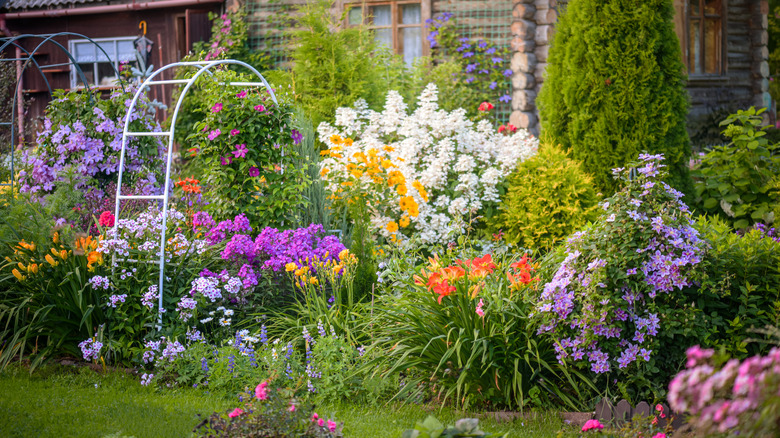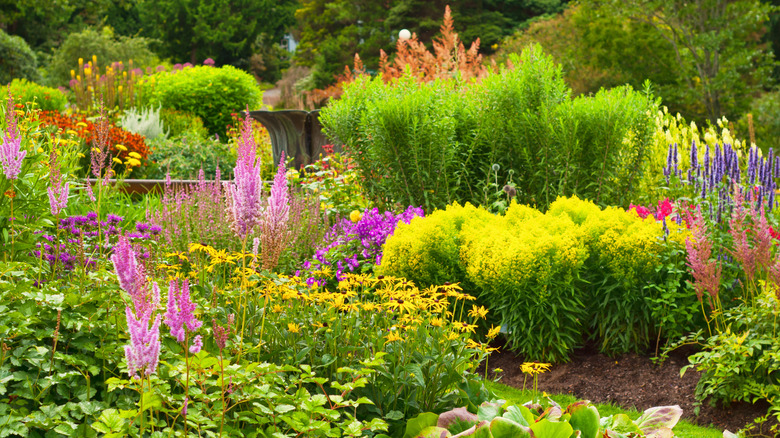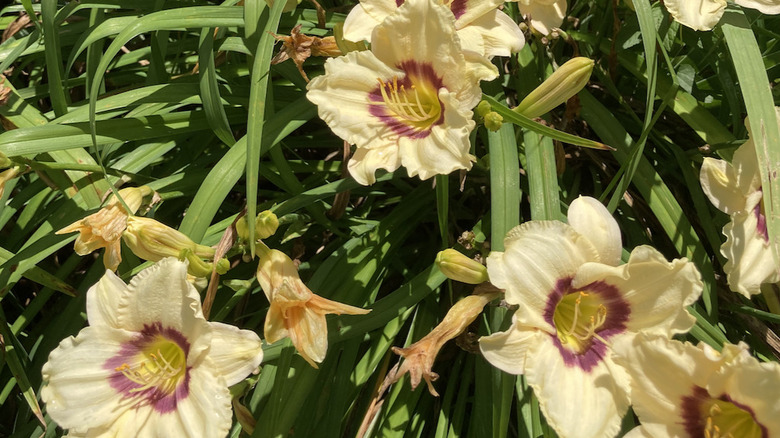The Garden Color That's Tricky To Use But Beautiful When Done Correctly
Most gardeners who grow flowers are partial to certain colors, or have a personal approach to using color. Some gardeners like cool pastels, some like warm bright hues, others enjoy a very specific palette (such as blue and white, or pink and purple). Using bold colors in the garden is eye-catching and adds energy at any time in the season. One vivid color that can be a little tricky due to its brightness is yellow, but it can be a beautiful addition to your garden color palette when done correctly.
One reason yellow is sometimes frowned upon is that it seems so common. Daffodils, forsythia, dandelions, lesser celandine, and other bright yellow flowers are among the earliest blooms to open in spring. The scientific reason behind this is that early spring flora in shades of yellow and white attract pollinators more readily than other colors. Abundant yellow in spring may convince some gardeners to choose cooler palettes for summer (pinks, purples, and blues). Yellow often shows up again in autumn gardens (chrysanthemums, rudbeckia, echinacea) accenting the red, gold, and orange leaves of deciduous trees as they shift with the season.
Yellow is one of those colors that can really boost a garden's visual appeal, but it's good to remember that with such a bright color, a little can go a long way. Choosing a variety of yellow hues such as an inviting pale butter yellow or a rich golden yellow can be a good alternative to the intensity of brighter variations. Fortunately, there are many shades of yellow in the plant world to help you add this sunny, happy color to your garden.
How to use yellow in the garden: hues and balance
Yellow can be used in so many ways to enhance the look of your garden design. Bright lemon yellow draws the eye, while pale yellow is soft and soothing and adds light — similar to white flowers. Golden yellows add a warm feeling, while deeper golds look rich and earthy. You can plant any number of yellow flowers, and/or plants with yellow foliage (like some yellow-green hostas, heucheras like 'Lemon Supreme' and 'Electra,' as well as some evergreens like 'Gold Thread' cypress). Some plants have foliage that turns yellow in fall (like many trees, as well as amsonia and sedums).
Combining yellow with colors that are complementary (opposite) or analogous (nearby on the color wheel) is a strong design choice. Bright yellow pairs well with blues and purples, from pale to dark. Pale yellows look great with deep pinks and oranges, and dark reds. Golden yellows have depth and warmth, and stand out next to cool blues and greens (think blue-toned hostas, junipers, and cypress). Yellow flowers in the autumn garden look great alongside burgundy or brown heucheras.
For analogous palettes, think blue-green-yellow, green-yellow-orange, or yellow-orange-red. These color combinations look fresh and vibrant in the spring, summer, or autumn garden, and you can add a range of hues for each color, like corals and pinks standing in for orange and red. Also, yellow-green foliage can look very striking alongside blue-green or silvery-blue foliage, as with hostas or artemisia, or with orange or red foliage, found in many heuchera varieties like 'Southern Comfort' or 'Fire Chief.'
Best yellow flowers for your garden
There are so many wonderful yellow flowers out there — it would take books to list them all! Yellow perennials can illuminate your garden through the season. Consider some yellow crocuses, daffodils, and/or tulip bulbs in early to mid spring. Mid to ate spring brings out perennials like yellow columbines, primroses, bearded irises, and lupines. Summer has many colorful perennials to choose from: Asiatic lilies, day lilies, coreopsis, yarrow, and coneflowers all come in an array of yellows. Many of these continue into autumn, alongside a number of yellow chrysanthemum varieties.
Perhaps you'd like to try yellow flowering shrubs beyond the (large, unwieldy) forsythia. Another wonderful early spring bloomer is Kerria japonica, with bright golden yellow flowers on a shrub that can be cut back every fall. There are many gorgeous yellow roses available, from the buttery yellow award winner 'Julia Child' to the cheery sunshine yellow heirloom climber 'Sky's the Limit,' to the easy care season-long blooms of the 'Sunny' Knock Out rose. There are also yellow flowering shrubs that attract many pollinators like the 'Honeycomb' butterfly bush (Buddleia) or the 'Hello Yellow' milkweed (Asclepias).
If you'd rather not have solid yellow blocks of color in the flower bed, many flowers add just a hint of yellow. Flowers with bright yellow centers attract pollinators, like Shasta daisies, asters, and "daisy" mums (try 'Clara Curtis' or 'Daisy Rose'). And don't forget bi-colors: many bearded irises ('Final Episode,' 'Sasparilla,' or 'Jurassic Park'), day lilies, snapdragons, and coreopsis have yellow and other colors combined. This can be a very creative way to add touches of yellow to the garden.


